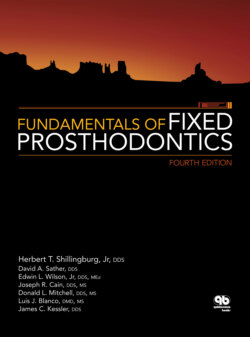Читать книгу Fundamentals of Fixed Prosthodontics - James C. Kessler - Страница 65
Mounting the maxillary cast
ОглавлениеThe articulator is prepared to receive the cast. The upper and lower members of the articulator are separated. The immediate lateral translation guide on the front of each condylar guide is moved outward to a setting of zero (Fig 5-17). This will prevent any lateral movement during mounting of the casts. A clean mounting plate is firmly secured to the upper member of the articulator. The incisal guide pin is removed. The transfer base is placed on the lower member of the articulator and secured by placing one of the metal mounting disks on the lower member magnet (Fig 5-18). The vertical rod of the transfer assembly is inserted into the transfer base, and the clamp screw is tightened (Fig 5-19).
Fig 5-20 The maxillary cast is seated in the bite fork registration.
Fig 5-21 The space between the base of the maxillary cast and the upper member of the articulator is checked.
Fig 5-22 Mounting stone is applied to the base of the cast.
Fig 5-23 A small amount of mounting stone is applied to the mounting plate on the upper member.
The bottom of the maxillary cast is indexed, and then the cast is soaked, tooth side up, in a plaster bowl. There should not be enough water to cover the teeth. The cast is carefully seated into the bite fork registration (Fig 5-20). The upper member of the articulator is placed on the lower portion of the articulator so that the front of the upper frame rests on the transfer assembly support bar (Fig 5-21). This is done to ensure that the cast does not contact the mounting plate while the upper member is fully seated on the lower member of the articulator. At this time, the amount of mounting stone required to mount the cast to the upper mounting plate is estimated.
Mounting stone is mixed to a thick, creamy consistency. The upper frame of the articulator is lifted, and a golf ball–sized mound of stone is applied to the base of the cast (Fig 5-22). A small amount of mounting stone is applied to the mounting plate on the upper member also (Fig 5-23). Using one hand for support to prevent any movement of the facebow fork or cast, the upper member of the articulator is placed on the condyles, and the anterior portion is lowered until contact is made with the support bar (Fig 5-24). This will force the mounting plate into the soft mounting stone. The centric latch is engaged to ensure that the condyles are in the correct position and contact the posterior and superior walls of the condylar fossae (Fig 5-25).
The mounting stone should engage undercuts on the base of the cast and the mounting plate. If necessary, more mounting stone is added into these areas to ensure adequate retention for mounting. When the stone has completely set, the transfer base and transfer assembly are removed from the articulator (Fig 5-26). Once the mounting of the maxillary cast is completed, the transfer assembly is separated from the bite fork. The transfer assembly is disinfected with a hospital-grade disinfectant and stored until the next use. All registration material is removed from the bite fork, which is then placed in a sealed sterilization bag and submitted for steam sterilization.
Fig 5-24 The upper member of the articulator is placed on the condyles (a) and lowered against the support bar (b).
Fig 5-25 The centric latch is engaged to lock the upper member of the articulator in the correct position.
Fit 5-26 The maxillary cast has been mounted on the articulator with the transfer base and transfer assembly removed.
